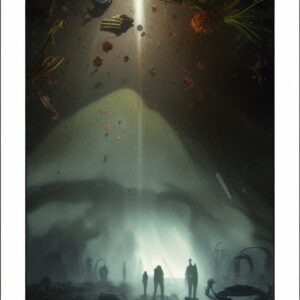
Venturing into space requires humanity to find ways to survive beyond Earth. One significant aspect of this survival is food. In this article, we explore the concept of interstellared edible landscaping and how it can be used to feed humans in colonized planets. We delve into the intricacies of dietary-engineered food and cooking in different planetary climates. The importance of sustainability and aesthetics in space agriculture is highlighted. We investigate the challenges of interstellar farming and the future of food technology in space. Finally, we conclude by weighing the pros and cons of interstellared edible landscaping as a solution for feeding humanity beyond Earth.
I. Introduction
The great beyond has always been a source of fascination for humanity. Countless sci-fi books, movies, and TV shows have explored the mysteries of space, but few have considered what we’d eat beyond Earth. For the adventurous spirit, leaving behind a home planet for the vast expanse of the stars involves much more than just getting there. It requires figuring out how to survive in an alien environment with little-to-no resources to work with.

Sustenance is one essential element of survival; however, space comes with an array of challenges that make food production and consumption not as straightforward as here on Earth. Factors like zero-gravity, intense radiation, and extraterrestrial environments require innovative and cutting-edge solutions to feed humanity in space.
One solution is interstellared edible landscaping: the practice of actively planting edible crops in and around a space habitat, allowing for self-sustenance in the colonies. From exotic fruits and vegetables to hardy grains, edible landscaping can bolster a colony’s nutrition and morale, while also contributing to the beauty and sustainability of the colony itself.
And, of course, understanding the nuances of gastronomy is incredibly important when it comes time to actually consuming food in these new environments. Interstellar cooking poses a unique set of challenges, from modifying recipes and cooking methods for alternative gravities and atmospheres to devising new food preservation techniques. As humanity sets its sights on exploring other planets, identifying comprehensive and adaptable methods for cooking and growing food will be crucial for long-term success and sustainability.
The exploration of space and the expansion of our civilization across the cosmos way will be remembered as one of the most significant eras in human history. With our ingenuity, bravery, and passion, we will ensure that we can travel far and wide, but also sustain ourselves and thrive. In this article, we will explore interstellared edible landscaping, and how its incorporation in space colonization may change the way we nourish ourselves beyond the reaches of our home planet.
II. Dietary Engineering
As humanity sets its sights on colonizing other planets, the need for self-sustenance becomes paramount. But just as the environments of planets vary, so too does their agricultural potential. And that means, we’ll need a new age of dietary engineering: designing foods for colonized planet’s climates. On Earth, centuries of agriculture have yielded crops that grow optimally within certain conditions, like temperature, humidity, and soil type. But on planets, these optima may require tweaking due to extreme atmospheric conditions, erratic light cycles, and different soil composition.

Luckily, technological advancements have brought us far — we now have a deep understanding of the science and mechanisms behind agriculture. We can alter the genetic makeup of plants to withstand new stressors and introduce heat-tolerant or water-saving genes through genetic engineering. We can also use selective breeding and other cutting-edge techniques to speed up the process of acclimatization.
Furthermore, understanding the nutritional needs of an interstellar crew is vital in maintaining their health and preventing mission drift. Nutrient-dense foods like leafy greens will play a role alongside high-energy foods like nuts and legumes. Long-duration space flights can cause dietary shifting for many astronauts as their bodies adjust to being in zero gravity, so scientists are devising ways to provide nutrition-dense meals that fit into a tube or a liquid format— similar to the squeeze pouches that babies use.
III. Cooking Beyond Earth
In the vast reaches of space, culinary arts take on a new dimension. Cooks and food technicians must come up with creative ways to prepare meals under unique conditions. For interstellar travelers, cooking beyond Earth is not just about making palate-pleasing dishes; it is a necessity.

The zero-gravity environment in spaceships, for example, poses significant challenges when it comes to cooking: fluids don’t settle, but food crumbs still float around, requiring the use of specially designed surfaces that can help keep equipment and ingredients in place. Astronauts’ diets undergo intense scrutiny, and food must have an extended shelf-life, all the while preserving the nutritional value of fruits and vegetables, proteins, and carbohydrates consumed on Earth.
Adaptation to new environments beyond Earth also involves developing new cooking methods based on local terrain, atmospheres, and gravity fields. Planets and moons that feature volcanoes with superheated gases and rocks instead of stovetops or high-tech microwaves will challenge interstellar chefs. Colonies established on planets with crushing atmospheres and scorching temperatures must concoct dishes to tolerate extreme heat or develop equipment that can keep food cold long enough for consumption.
Nevertheless, some culinary traditions in Earth’s many different cultures and societies have provided solutions to problems that may manifest in interstellar travel. Techniques like dehydration, smoking, and fermentation that are commonly used in many dishes can dehydrate, smoke, ferment, and pickle ingredients to produce rich flavors that can last for extended stays in space.
In the vast and uncharted territories of space, humanity’s palate will encounter many flavors and textures undreamt of. Colonists must learn to cope with taste limitations, developing time-delayed authentic flavors that make them feel at home, rather than the strange new worlds they have settled on. Salivating as food floats across a low-gravity dining hall in their advanced habitats, interstellar colonists will use their nerves and creativity to savor the sweet taste of home amongst the expanse of the stars.
IV. Sustainability in Space
When venturing beyond Earth, we must learn to rely on ourselves. In space exploration, self-sufficiency is key to survival, as a lack of sustainable resources off-planet can be devastating. Doing so involves integrating sustainability principles into all aspects of space life, from the design of spacecraft and infrastructure to the maintenance of a productive and healthy landscape.

The use of interstellared edible landscaping in space colonies aligns perfectly with sustainable practices. Not only does it reduce the need to import goods from Earth, but it also aids in the creation of a self-sustaining ecosystem within the colony. This is essential, as transporting goods into space costs millions, if not billions, of dollars per launch, and the items transported may have a short shelf-life due to storage restrictions and other unknowns.
Furthermore, the process of integrating a sustainable approach to space exploration can help promote awareness of the ecological impact of space activities, highlighting the importance of minimizing the impact of human activities on planetary environments. By creating closed loops of energy and resources, sustainable practices can help to ensure that future space exploration activities can continue indefinitely, without doing irreversible harm to the cosmos.
The importance of sustainability in space cannot be overstated, as the survival of humankind beyond Earth may depend on it. Every aspect of space colonization must be evaluated for efficiency, reliability, and sustainability. Creating a sustainable food production system is one of many key steps in achieving successful colonization. It requires planning, ingenuity, and replication of environmental systems that allow for the sustained growth of life and the prosperity of the colony. In this regard, interstellared edible landscaping is a powerful tool in fulfilling humanity’s desperate need for food, beauty, and aesthetics, which needs intensive care and detailed attention to provide a reliable and consistent source of sustenance for those that journey beyond the stars.
V. Aesthetics and Agriculture
Aesthetics are essential to human thriving, and agriculture is no exception. In interstellar colonization, edible landscaping must be both beautiful and productive. Colony inhabitants need to be able to enjoy their surroundings while utilizing their crops for sustenance. Engaging all the senses during mealtime is vital, especially in the confines of an artificial habitat.

To achieve both productivity and aesthetic appeal, interstellared agriculture must take a multi-disciplinary approach. Architects, artists, botanists, chefs, and farmers must collaborate to create a harmonious and sustainable system that satisfies both the needs and wants of the colonists. Considerations, such as lighting, soil composition, and irrigation, must be balanced with the beauty of the landscape. The results will not just be functional, but they will also be beautiful to behold.
Another aspect of designing beautiful and productive edible landscapes is the promotion of biodiversity. If all the colonists were to eat only one kind of food, it could lead to nutritional deficiencies and other health problems. Biodiversity is critical to sustaining people on Earth, and it will remain just as crucial in space. By growing various kinds of crops and utilizing different breeding strategies, interstellar colonists can ensure that they are getting a well-rounded diet while also promoting genetic variety in their crops. Additionally, growing food in multiple ways – such as hydroponics, aeroponics, and vertical farming – helps to ensure a more complete balance of nutrients and offers a richer taste and texture as well.
The beauty and productivity of an interstellared landscape must be considered as a whole. This system can be shaped not just for its practical requirements but its artistic potential too. By combining their visual appeal with a variety of crops and optimal breeding strategies, edible landscapes can enhance the experience of space colonization beyond the culinary. By prioritizing aesthetic considerations in agriculture, we can help to create environments that are both productive and beautiful – something that is essential to our well-being, whether we are on Earth or in the depths of the cosmos.
VI. Challenges of Interstellar Agriculture
While interstellar edible landscaping seems like a promising solution for feeding colonists beyond Earth, a multitude of challenges exist that make space agriculture far from easy. Perhaps the most significant challenge is gravity. On Earth, gravity plays a critical role in maintaining natural irrigation, and it affects the way plants grow. Growing plants in zero-gravity or low-gravity environments, like those found on the Moon or Mars, requires alternative techniques, from hydroponics to aeroponics.

Space travel also comes with the added irritation of intense radiation exposure. With little atmosphere to act as a shield, deep space and colonized planets are bombarded with high-energy particles. This radiation can damage plant cells and DNA, inhibiting their growth and even killing them outright. Therefore, developing techniques to shield plants from radiation exposure is essential for successful space agriculture.
Agriculture on colonized planets also poses a unique sustainability challenge. The reuse of waste and control of the nutrient cycle will be critical to maintaining a steady supply of resources for both crops and humans. In space environments, proper waste management is crucial, as human waste can be converted into compost or fertilizer for plants. The nutrient loop can be established by cultivating plants that produce edible leaves and stems of huge nutrient and water value; however, care must be taken not to produce waste that will pollute the environment.
Finally, one must acknowledge the challenges of transporting necessary agricultural crops to interstellar colonies. Are hydroponics structures, seeds, automated gardening machinery, or even soil worth taking up space in a limited transporter with other necessities? Or should these items be manufactured on a local level with methods such as 3D printing or other innovative technologies? The answers to these questions will play a significant role in enabling success in space agriculture endeavors.
Navigating the challenges of space agriculture will eventually require the rapid adaptation of technologies and techniques. But with dedication and ingenuity, we might pave the way for an era where agriculture thrives in new and unlikely environments – even in the vast emptiness of space.
VII. Future of Interstellar Cuisine
As with any frontier, outer space brings a variety of new flavor profiles and cuisines, and interstellar cuisine promises to be as diverse as it is delicious. Advancements in food technology are driving humanity’s food production capabilities to new heights. From 3D-printed steaks to lab-grown fish fillets, the future of food extends beyond this world.

Most prominently, biotechnology has become instrumental in not just creating synthetic food but also modifying existing organisms to resolve the unique challenges of farming in space. Biotech advancements like vertical farming and genetically modified crops have already revolutionized terrestrial agriculture. They show promise in space too. Genetically enhanced crops that are resistant to radiation or that produce more nutritious yields are only a few examples of the possibilities.
Another promising arena is extraterrestrial farming – the practice of farming extra-terrestrial organisms for food. Astro-farmers are exploring whether sandworms on Mars could become a vital protein source, and many other hybrid edible-alien plant species are being considered. As well, combining earth-grown crops with extraterrestrial soils like regolith could be a fantastic solution, leading to truly unique flavor combinations and nutritional profiles.
Finally, the rise of automation, AI, and robotics is leading to novel food production and preparation methods. With autonomous irrigation systems that can adapt to local meteorological conditions to programmatic cooking robots that can cook, plate and serve food, we will witness a new era of culinary creation as humanity begins colonizing space. Gone are the days of mundane space meals where everything comes packaged and processed, interstellar cuisine will be every bit the topic of culinary conversation in the decades and centuries to come if not more!
All in all, space may be the final frontier for humanity, but it is no longer a barrier to creating gourmet dishes fit for a king. With groundbreaking technology and innovative ideas, interstellar dining could become a sustainable and delicious part of humanity’s future.
VIII. The Pros and Cons of Edible Landscaping in Space
Like anything, interstellared edible landscaping comes with its share of pros and cons, and it’s essential to weigh them carefully before implementing such a crucial aspect of a planetary colony’s infrastructure.

Among some of the benefits of interstellared edible landscaping include the production of fresh, nutritious food, improving morale among colonists, and the potential to reduce overall resource costs. This practice can also create an aesthetically pleasing environment, which can have positive psychological effects on inhabitants.
There are, however, potential downsides of implementing interstellar agriculture in a colony. The initial costs of building greenhouses, micro-environments, and acquiring supplies to make suitable soils may be steep. Additionally, growing crops in a zero-gravity environment can pose unique challenges that require extensive research and development to tackle.
There are also concerns about how interstellar agriculture could impact the environment surrounding the colony in the long-term. Introducing Earth-based flora and fauna to an alien environment could have unforeseen ecological consequences for that planet. Limitations on resources like water or fertile soil can also pose a significant challenge to any agricultural pursuits.
Ultimately, whether interstellared edible landscaping is the right choice for any individual colony depends on the specific circumstances of that location. The benefits of fresh food and a healthier community are significant, but designing and maintaining living, breathing landscapes in space requires significant resources and planning. We must weigh the costs and benefits carefully and use our collective wisdom and technology to make the most of our endeavors. In the end, the potential of interstellared edible landscaping to improve the quality of life for colonists and bring us one step closer to making space our permanent home make it an endeavor worth exploring.






